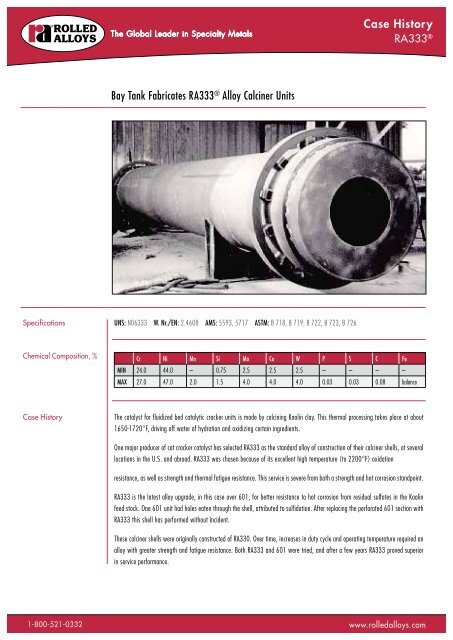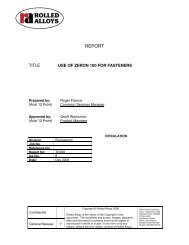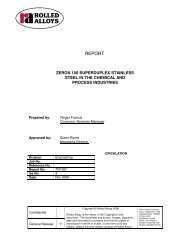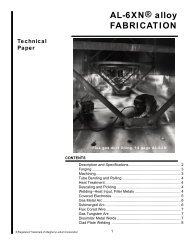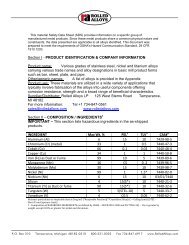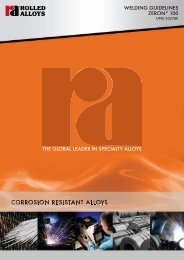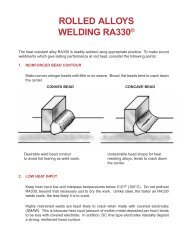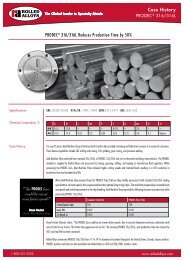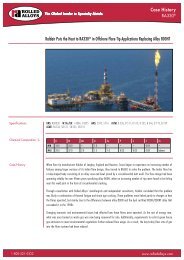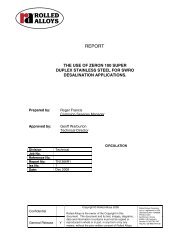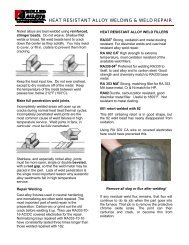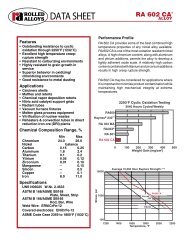RA333 Calciner Shell - Rolled Alloys
RA333 Calciner Shell - Rolled Alloys
RA333 Calciner Shell - Rolled Alloys
Create successful ePaper yourself
Turn your PDF publications into a flip-book with our unique Google optimized e-Paper software.
The Global Leader in Specialty Metals<br />
Case History<br />
<strong>RA333</strong> ®<br />
Bay Tank Fabricates <strong>RA333</strong> ® Alloy <strong>Calciner</strong> Units<br />
Specifications UNS: N06333 W. Nr./EN: 2.4608 AMS: 5593, 5717 ASTM: B 718, B 719, B 722, B 723, B 726<br />
Chemical Composition, % Cr Ni Mn Si Mo Co W P S C Fe<br />
MIN 24.0 44.0 – 0.75 2.5 2.5 2.5 – – – –<br />
MAX 27.0 47.0 2.0 1.5 4.0 4.0 4.0 0.03 0.03 0.08 balance<br />
Case History<br />
The catalyst for fluidized bed catalytic cracker units is made by calcining Kaolin clay. This thermal processing takes place at about<br />
1650-1720°F, driving off water of hydration and oxidizing certain ingredients.<br />
One major producer of cat cracker catalyst has selected <strong>RA333</strong> as the standard alloy of construction of their calciner shells, at several<br />
locations in the U.S. and abroad. <strong>RA333</strong> was chosen because of its excellent high temperature (to 2200°F) oxidation<br />
resistance, as well as strength and thermal fatigue resistance. This service is severe from both a strength and hot corrosion standpoint.<br />
<strong>RA333</strong> is the latest alloy upgrade, in this case over 601, for better resistance to hot corrosion from residual sulfates in the Kaolin<br />
feed stock. One 601 unit had holes eaten through the shell, attributed to sulfidation. After replacing the perforated 601 section with<br />
<strong>RA333</strong> this shell has performed without incident.<br />
These calciner shells were originally constructed of RA330. Over time, increases in duty cycle and operating temperature required an<br />
alloy with greater strength and fatigue resistance. Both <strong>RA333</strong> and 601 were tried, and after a few years <strong>RA333</strong> proved superior<br />
in service performance.<br />
1-800-521-0332<br />
www.rolledalloys.com
1-800-521-0332<br />
www.rolledalloys.com<br />
Case History, Continued<br />
Bay Tank and Fabricating Company, Inc. of Panama City, FL is the ASME code shop which was selected to fabricate the three calciner<br />
units of <strong>RA333</strong>. Even though <strong>RA333</strong> is not a common alloy of construction at Bay Tank, they maintained the proficiency needed to<br />
fabricate all high performance engineering alloys. They were able to handle the <strong>RA333</strong> alloy fabrication in stride, using standard<br />
fabrication practices and equipment.<br />
Bay Tank constructed these calciner units with a 5 ft. dia., 35-1/2 ft. long (1500 mm x 10800mm) shell of 3/8” (9.5 mm) <strong>RA333</strong><br />
plate. The shell seam was welded over an internal cage of <strong>RA333</strong> square bar, using <strong>RA333</strong>-70-16 AC/DC titania electrodes. Bay Tank<br />
opted to use SMA welding (covered electrodes over the faster sub-arc process in order to keep heat input low. Although it was not<br />
required, Bay Tank elected to X-ray the welds after the cap pass was applied to assure full penetration, crack free welds. Shearing and<br />
rolling of the <strong>RA333</strong> alloy was achieved with standard equipment without difficulty. To quote the Bay Tank spokesman, “The alloy<br />
formed and rolled like 304 stainless steel. We even rolled the square bar on our plate roller! The <strong>RA333</strong> patterns and smaller pieces<br />
were cut with plasma.”<br />
<strong>RA333</strong> alloy is a nickel based super alloy with outstanding resistance to high temperature oxidation and carburization. This grade<br />
has exceptional ability to withstand thermal cycling and shock and can withstand corrosive environments from room temperature to a<br />
white heat. This 45% nickel, 25% chromium alloy gets its name from its unique 3 % molybdenum, 3 % cobalt, 3 % tungsten addition.<br />
Other applications include dampers, thermowells, flare tips, molten glass process equipment, radiant tubes, retorts, and various kilns.<br />
Visit rolledalloys.com for more information or <strong>RA333</strong> or any other <strong>Rolled</strong> <strong>Alloys</strong> grades.<br />
<strong>RA333</strong> is a registered trademark of <strong>Rolled</strong> <strong>Alloys</strong><br />
The Global Leader in Specialty Metals<br />
www.rolledalloys.com<br />
© 2011 <strong>Rolled</strong> <strong>Alloys</strong><br />
Bulletin No. 2017USe 10/11<br />
The data and information in this printed matter are believed to be reliable. However, this material is not intended as a substitute for competent professional engineering assistance which is a requisite to any specific application. <strong>Rolled</strong> <strong>Alloys</strong> makes no<br />
warranty and assumes no legal liability or responsibility for results to be obtained in any particular situation, and shall not be liable for any direct, indirect, special, or consequential damage therefrom. This material is subject to revision without prior notice.


